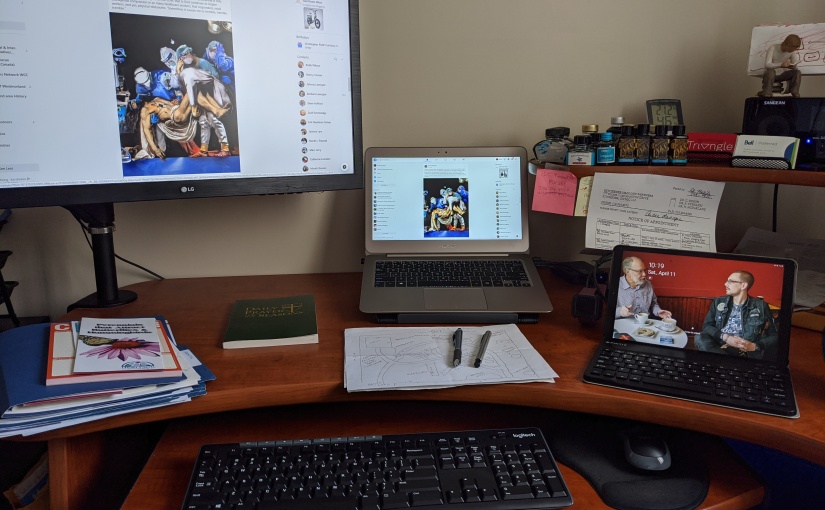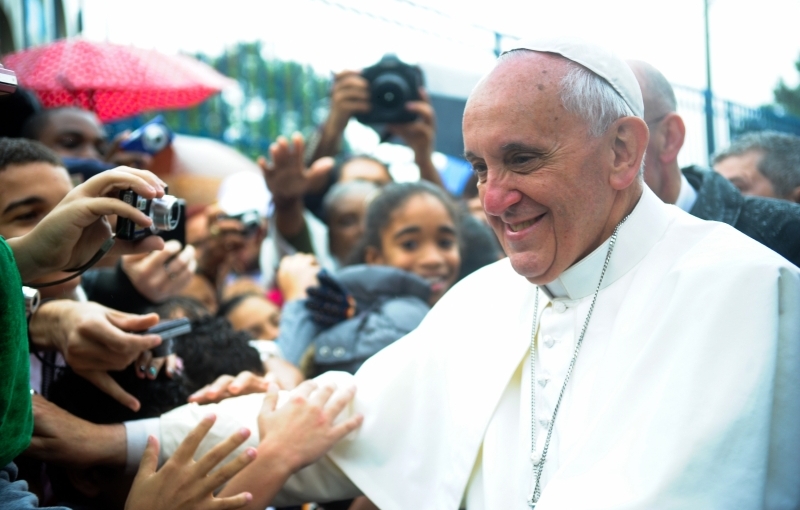In a few hours, Barbara and I will head out for worship for the first time since churches closed their doors back in March.
I got a new hip, a couple of weeks ago, so this is a coming out adventure in every sense. Our community will be doing its third week of in-person-under-COVID-rules worship, so we’re just catching up. We’re looking forward to something which has greatly touched those who have already gone. So while together, we’ll be apart, checker-boarded, having signed-up in advance to go. There’ll be no touching; no singing; no wine at communion and no coffee klatch afterward. These are the rules. This will be as close to Holy Communion—the sacrament—as our Holy Communion—the assembly of believers—will come.
All of which makes me want to pick up where I left off at the end of May. If you haven’t read “Holy Communion?” (my last blog) please do so.
Thing three. Early in the last COVID-19 wave, I used the terms “table fast” and “eucharistic fast” to describe where I was during the pandemic. Many were using the latter term but many were also using it imprecisely and, possibly, incorrectly. For some it was the term used by their bishop who “invited her community to join her in a eucharistic fast.” For others it simply meant “I’m not communing right now.”
At one point, I was taken to task for not really being on a fast so much as an imposed diet. The table is closed, after all; no more communion for you! My friend had a point which I completely understood. If something is foist upon you, you haven’t foisted it upon yourself. Therefore you are not fasting. You cannot eat and drink what isn’t offered you. That’s not a fast. I get it.
I replied to my colleague, “I’m not fasting from business-as-usual Holy Communion, I’m fasting from the electronic alternatives that have been conjured in recent days.” Again, I wasn’t taking a theological position. In fact, I wasn’t even reflecting a particular comfort level about electronic communion at all. That wasn’t the issue.
My concern with participation in these alternative is that they made something possible for a few techno-well-off people, something which was denied many. It was available to the technologically aware and savvy and those who could afford it. It was denied, in large part, to people who were already vulnerable for reasons related to the very essence of COVID-19: people in elder care facilities and others who were not familiar with, and not embraced by, the technologies used to bring the sacrament of holy communion home. A double whammy.
Last night, we watched Annamie Paul elected to be the leader of the Green Party of Canada. In her acceptance speech, she mentioned that her father had died in May from a treatable infection because he was not able to get out of his seniors’ home to get the help he needed. I’m sure that all of us watching were arrested by Ms Paul’s speech. Unfortunately, her father was in the dire straights of a great many people, and people who lost their lives, under the first COVID curve.
Electronic communion or distance communion seems to me to add one more piece of life-denied to those who are denied much already.
Simply put, people on the outside of elder care could “commune” in this new way while those who were incarcerated might not have the option at all. I believed myself (as did some conversation partners) to be fasting from a privileged alternative quite apart from the question of whether we should or should not be offering and receiving “distance/mediated/cyber/virtual communion.” All of these terms were used in the early days of March and April, 2020. Eucharistic solidarity is more like what I was thinking and what I shared with a number of close friends. But, in any event, I think it really was a fast and not a diet.
Thing Four. It seems to me, that one of the options I might have expected for Lutherans is for bishops or pastors to train lay people to offer communion in their own bubbles, no remote pastors confecting things remotely: “In these exceptional pandemic times we will teach people to do word and sacrament ministry in their own particular bubbles until we can gather, once more, in our regular and full assemblies of believers.” Something like that. Electronic media could have a valuable life providing God’s word as expressed by community pastors and deacons, together with useful helps and examples for the local faithful. Deacons could be helpful in the teaching effort as training up the faithful is usually an aspect of what makes deacons deacons.
This direction would likely have required a pause to think things through as a larger community (larger than this or that assembly of believers) or this or that Zoom call. I think a pause to think things through was seriously lacking as people rode off in all directions in the first wave. I also think that our leaders at all levels felt stampeded as the world of COVID overtook our conversations and clogged the airwaves and our inboxes.
In any event, the working out of the sort of priesthood of all believers effort contemplated here would be consistent with core Lutheran thought in which pastors are seen as deputized in ordination to do what lay people could do if no pastors existed—as when the plane crashes on the desert island with no pastors to rally the survivors or to bury the dead. The community buries its dead and gets on with its spiritual, devotional and sacramental life.
Lutherans have an essentially flat ecclesiology. Our ecclesiology is strictly a matter of the pragmatic training and setting apart of people to perform particular functions, the functions peculiar to being a bishop, deacon or pastor. That’s how we get to pastors, deacons and bishops in the first place. We know the categories from the ecumenical mainstream, find them appealing, and see particular candidates as helpful believers with aptitudes and gifts useful to the church.
Distance communion creates the impression that pastors are necessary for our people to lead and to have a full sacramental life. That is only the case if we want it to be the case. But it needn’t be. Potentially more important functions for pastors in pandemic times might have to do with (1) helping people living in bubbles to have such resources as they might require to live full and faithful lives in tough times and (2) connecting the bubbles which make up the local Christian community for succor and support and the collective wisdom of the faithful.
Under the special circumstances of a pandemic, we might well want to restore to lay people in their bubbles the work of the priesthood of all believers. These local bubbles might include the incarcerated and the otherwise inaccessible in a way which other mechanisms do not. I’m thinking here of people who are given special dispensation and permission to visit people in hospitals, elder care, etc. Perhaps the second wave might offer us opportunities not apparent or seized in the first.
So for now. We’re heading out in a few minutes to go to church. It feels good to be getting out of the house.
André +
André Lavergne — writing from a settler-descendant’s home on the traditional lands of the Neutral, Anishnaabe, and Haudenosaunee peoples on the Haldimand Tract (1784).








